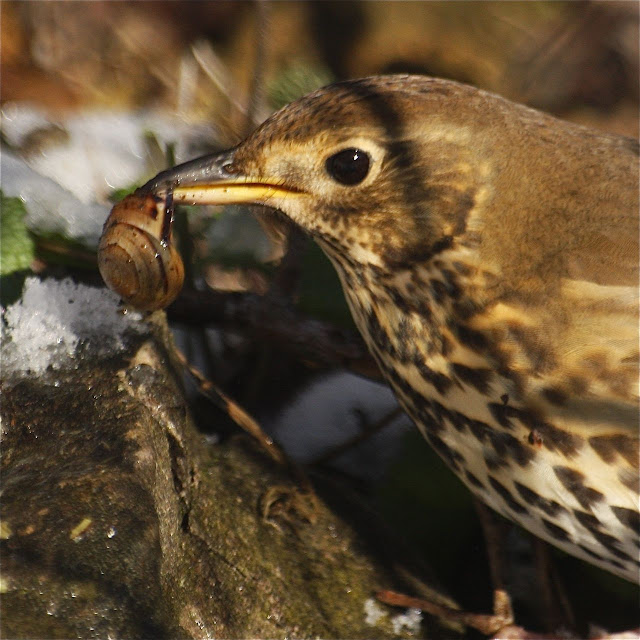I took these photos in the Hermitage of Braid, Edinburgh, on Saturday morning. With so much snow on the ground, stones suitable for use as anvils must have been at a premium and two Song Thrushes were competing for access to this rock, one of which is shown below. The snail is a banded or grove snail (Cepaea nemoralis) - a very common prey item for this thrush. With a few well-aimed sideways flicks of the head the thrush cracks the snail's shell on the rock, gives it a quick wipe and then swallows the defenceless prey. On a cold, crisp and dry morning like this the snails seemed to be a good supply of both food and moisture.
 From the photos it is clear that the Song Thrush closes its nictitating membranes at each moment of impact. These translucent third eyelids have a protective function - in the photograph below notice the shell fragments in mid air.
From the photos it is clear that the Song Thrush closes its nictitating membranes at each moment of impact. These translucent third eyelids have a protective function - in the photograph below notice the shell fragments in mid air.
More rounded tail feathers feathers on this bird indicated that it is an adult - something that appears to be confirmed by the efficiency with which it was able to both find and dispatch a snail. This is a learned behaviour - young Song Thrushes attempt to smash snails on non-anvils and non-snails on anvils before they get the behaviour right. The shot below shows the final blow, before the snails body was tossed deftly into the gullet.
After a quick pause, the bird was back with another banded snail. Notice that this snail is of a different colour morph to the one above. Studies since the 1950s have found that Song Thrushes tend to select the most conspicuous morphs preferentially, and this predation seems to be a major selection pressure for colour polymorphism in the snails. The yellow-banded forms appear to better camouflaged in grassland habitats, whereas the darker forms are better camouflaged in woodland habitats. In addition, it is likely that there is also a major environmental influence. Exposed habitats and sunnier climates tend to have more pale morph snails as these shells are less likely to overheat.
A quick pause and then off for more.





No comments:
Post a Comment